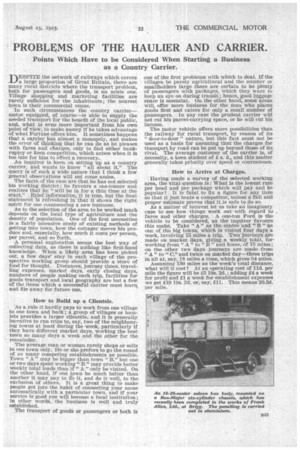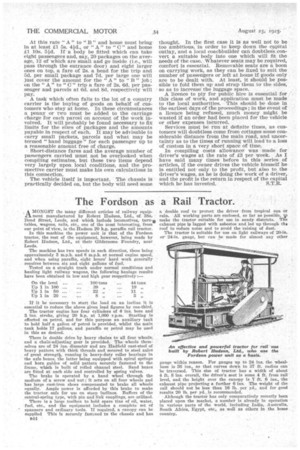PROBLEMS OF THE HAULIER AND CARRIER.
Page 25

Page 26

If you've noticed an error in this article please click here to report it so we can fix it.
Points Which Have to be Considered When Starting a Business as a Country Carrier.
TVESPITE the network of railways which covers Lira large the of Great Britain, there are many rural districts where the transport problem, both for passengers and goods, is an acute one. :Village shopping and marketing facilities are rarely sufficient for the inhabitants ; the nearest town is their commercial venue.
In such circumstances the country carrier— motor equipped, of course—is able to supply the needed• transport for the benefit of the local public, and, what is even more important from his own point of view, to make money if he takes advantage of what Fortune offers him. It sometimes happens that a carrier has almost a monopoly, and makes the error of thinking that be can do as he-pleases with fares and charges, only to find either bankruptcy or keen competition, which arises when it is too late for him to effect a recovery.
• An inquirer is keen on. setting up as a country carrier, and wants to know "all about it." The query is of such a wide nature that I think a few general observations will not come amiss.
The facts of the case are that he has not selected his working district ; he favours a one-tanner and realizes that he "will be in for a thin time at the start." Brief information, it is true, but the final statement is refreshing in that it shows the right spirit for one commencing a new business.
As to the selection of the area to be worked much depends on the local type of agriculture and the density of population. One of the first necessities is a fairly intensive study of existing methods of getting into town, how the cottager moves his produce and, especially, how much it costs per person, per parcel, and so forth.
A personal exploration seems the best way of collecting data, as there is nothing like first-hand knowledge. When a likely area has been picked out, a few days' stay in each village of the prospective working group should provide a store of food for thought. Distances, journey times, travelling expenses, market days, early closing days, numbers of people making each trip, facilities for goods transport and local geography are but a few of the items which a successful carrier must learn and file away for future use.
How to Build up a Clientele.
As a rule it hardly pays to work from one village to one town and back ; a group of villages or ham lets provides a larger clientele, and it is generally lucrative to run trips to, say, two of the neighbouring towns at least during the week, particularly if they have different market days, working the best town so many days a week and the ether for the remainder.
The average man or woman rarely shops or sells in one town only. He or she prefers to go the round of as many competing establishments as possible. Town " A " may be bigger than town "B," but one or two days spent working" B" may provide better weekly total loads than if " A" only be visited. On the other hand, if one town be much better than another it may pay to do it, and do it well, to the exclusion of others. It is a great thing to make people get into the habit of connecting your name automatically with a particular town, and if your service is good you will become a local institution ; in other words, the business is well and truly established.
The transport of goods or passengers or both is one of the first problems with which to deal. If the villages be purely agricultural and the number Or smallholders large there are certain to be plenty of passengers with packages, which they want to keep an eye on during transit ; hence, good luggage space is essential. On the other hand, some areas will_ offer more business for the man who places goods first and caters for only a small number of passengers. In any case the prudent carrier will not cut his parcel-carrying space, or he will cut his income.
The motor vehicle offers more possibilities than the railway for rural transport, by reason of its " door-to-door " nature, but this fact must not be used as a basis for assuming that the charges for transport by road can be put up beyond those of its rival. The average customer of the carrier is, of necessity, a keen student of E s. d., and this matter generally takes priority over speed or convenience.
How to Arrive at Charges.
Having made a survey of the selected working area, the vital question is : What is the lowest rate per head and per package which will pay and be popular? It is fatal to fix a figure for any item so that it just beats a competitor, unless a full and proper estimate proves that it Is safe to do so. As a matter of interest let us take an imaginary case to see how things work out with regard to fares and other charges. A one-ton Ford is the vehicle to be considered, as the inquirer favours this make. Take " A " as the centre and "B " as one of the big towns; Which is visited four days a week, involving 15 miles a trip. Two journeys are made on mai ket days, ,giving, a weekly total, for working from " A " to " B " and home, of 75 miles ; on the other two days -journeys are made from " A " to "C," and twice on market day—three trips in all at, say, 18 miles a time, which gives 54 miles. Assuming 130 miles as the week's total distance, what will it cost? At an operating cost of lid, per mile the figure will be £5 19s. 2d. ; adding Di a week for profit and £1 a week for establishment expenses we get £10 10s. 2d. or, say, £11. This means 20.3d. per mile.
At this rate " A " to " B " and home must bring in at least Li 5s. 4111., or " A " to " C " and home Li 10s. 5id. If a body be fitted which can take eight passengers and, say, 20 packages on the average, 12 of which are small and go inside (i.e., will pass through the entrance door) and eight larger ones on top, a fare of 2s. a head for the trip and 5d. per small package and 7d. per large one will just cover the amount for the " A " to " B " job ; on the " A " to " C " trip a fare of 2s. 6d. per passenger and parcels at 6d. and 8d. respectively will pay.
A task which often falls to the lot of a country carrier is the buying of goods on behalf of customers who stay at home. In these circumstances a penny or two must be added to the carriage charge for each parcel on account of the work involved. It will probably be found necessary to fix limits for the sizes of packages and the amounts payable in respect of each. It may be advisable to carry small packets, parcels and what may be termed " hand luggage" for each passenger up to a reasonable amount free of charge.
Short-distance fares and the average number of passengers carried must not be overlooked when compiling estimates, but these two items depend very largely upon local conditions, and the prospective carrier must make his own calculations in this connection.
Thevehicle itself is important. The chassis is practically decided on, but the body will need some thought. In the first case it is as well not to be too ambitious, in order to keep down the capital outlay, and a local coachbuilder can doubtless convert a suitable body into one which will fit the needs of the case. Whatever seats may be required, comfort is essential. Removable seats are a boon on carrying work, as they can be fixed to suit the number of passengers or left at home if goods only are to be dealt with. At least, it should be possible to fold them up and strap them to the sides, so as to increase the luggage space.
A licence to ply for public hire is essential for this class of work, and application must be made to the local authorities. This should be done in the earliest days of the proceedings ; in the event of a licence being refused, much money might be wasted if an order bad been placed for the vehicle or other expenses inCurred.
Services must be run at definite times, as customers will doubtless come from cottages some considerable distance from the main road, and uncertainty as to the times of running will lead to a loss of custom in a very short space of time.
In compiling costs allowance was made for driver's wages at the rate of £3 per week. As I have said many times before in this series of articles, if the owner drives the vehicle himself he is entitled not only to the profit, but also to the driver's Wages, as he is doing the work of a driver, and the profit is the return in respect of the capital which he has invested. S.T.R.




























